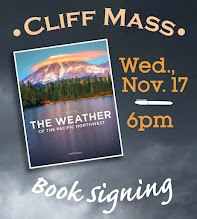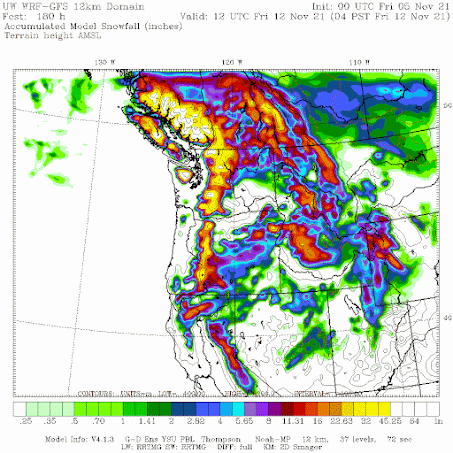First, an announcement.
I will be doing a book signing and dinner event at Ivar's Salmon House in Seattle on Wednesday, November 17th (6 PM). You can come just to purchase a book and get it personalized or you can stay for a special dinner, where I will be giving a weather talk. More information on the event is found here. You need to make reservations for the dinner (only 80 spaces available). And information about the new edition of my book is here.
In any case, it will be nice to meet some of you in person after the long COVID period.
La Nina Has Strengthened
La Nina, the cooling of the central and eastern tropical Pacific, has strengthened, and this has big implications for our winter, particularly after January 1. Think snow. I will discuss this in my podcast.
The Start of the Cascade Snow Season
And talking about snow, with cooling temperatures and lots of precipitation, the latest model runs suggest LOTS of the white stuff during the next week (see UW WRF model forecast of accumulated snow below). We are talking several feet above 4000 ft.
You can listen to the podcast below or through your favorite podcast server.







Does a cooler, showery winter mean an increased probability of icy roads in the Willamette Valley this winter?
ReplyDeleteWish I could be there, good luck on your book signing and presentation!
ReplyDeleteCliff states that this will be another La Nina winter, as was last winter, with the chance that it will be colder and snowier than usual. Recent La Nina winters, at least here in Wenatchee, have not been especially cold, in fact, compared to the long term (1950 to 1993) normal temperatures at the Tree Fruit Research Center in Wenatchee, they have been on the mild side. Here are the average two-month January/February temperatures for the past five La Nina winters: 2000:+0.2. 2008:-0.6. 2011:+1.9 2012:+1.8 2021: +3.4. In fact, compared to some of the winters prior to about 1980, we haven't had a significantly cold winter in any year recently, possibly due to global warming. Maybe we will get by this winter also.
ReplyDeleteI live in North Bend. When everyone else is gusting to 40mph, we get 50mph. The Snoqualmie Valley, more wind, more rain, and there's 30,000 people out here!
ReplyDeleteIf La Niña is typically more impactful after January, is the current October/November rain storm train just a normal seasonal variation pattern or does it correlate with La Niña?
ReplyDelete